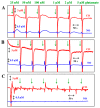Amperometric Microsensors Monitoring Glutamate-Evoked In Situ Responses of Nitric Oxide and Carbon Monoxide from Live Human Neuroblastoma Cells
- PMID: 28753952
- PMCID: PMC5539859
- DOI: 10.3390/s17071661
Amperometric Microsensors Monitoring Glutamate-Evoked In Situ Responses of Nitric Oxide and Carbon Monoxide from Live Human Neuroblastoma Cells
Abstract
In the brain, nitric oxide (NO) and carbon monoxide (CO) are important signaling gases which have multifaceted roles, such as neurotransmitters, neuromodulators, and vasodilators. Even though it is difficult to measure NO and CO in a living system due to their high diffusibility and extremely low release levels, electrochemical sensors are promising tools to measure in vivo and in vitro NO and CO gases. In this paper, using amperometric dual and septuple NO/CO microsensors, real-time NO and CO changes evoked by glutamate were monitored simultaneously for human neuroblastoma (SH-SY5Y) cells. In cultures, the cells were differentiated and matured into functional neurons by retinoic acid and brain-derived neurotrophic factor. When glutamate was administrated to the cells, both NO and CO increases and subsequent decreases returning to the basal levels were observed with a dual NO/CO microsensor. In order to facilitate sensor's measurement, a flower-type septuple NO/CO microsensor was newly developed and confirmed in terms of the sensitivity and selectivity. The septuple microsensor was employed for the measurements of NO and CO changes as a function of distances from the position of glutamate injection. Our sensor measurements revealed that only functionally differentiated cells responded to glutamate and released NO and CO.
Keywords: amperometric sensor; carbon monoxide; glutamate stimulation; neuroblastoma cells; nitric oxide.
Conflict of interest statement
The authors declare no conflict of interest.
Figures




Similar articles
-
Insertable NO/CO Microsensors Recording Gaseous Vasomodulators Reflecting Differential Neuronal Activation Level with Respect to Seizure Focus.ACS Chem Neurosci. 2017 Sep 20;8(9):1853-1858. doi: 10.1021/acschemneuro.7b00141. Epub 2017 Jul 5. ACS Chem Neurosci. 2017. PMID: 28661136
-
The real-time in vivo electrochemical measurement of nitric oxide and carbon monoxide release upon direct epidural electrical stimulation of the rat neocortex.Analyst. 2015 May 21;140(10):3415-21. doi: 10.1039/c5an00122f. Epub 2015 Mar 9. Analyst. 2015. PMID: 25751504
-
Simultaneous electrochemical detection of nitric oxide and carbon monoxide generated from mouse kidney organ tissues.Anal Chem. 2007 Oct 15;79(20):7669-75. doi: 10.1021/ac070814z. Epub 2007 Sep 19. Anal Chem. 2007. PMID: 17877421
-
Physiologically relevant measurements of nitric oxide in cardiovascular research using electrochemical microsensors.J Vasc Res. 2006;43(1):70-85. doi: 10.1159/000089547. Epub 2005 Nov 4. J Vasc Res. 2006. PMID: 16276114 Review.
-
Gases as biological messengers: nitric oxide and carbon monoxide in the brain.J Neurosci. 1994 Sep;14(9):5147-59. doi: 10.1523/JNEUROSCI.14-09-05147.1994. J Neurosci. 1994. PMID: 8083727 Free PMC article. Review.
References
-
- Bidmon H.-J., Emde B., Oermann E., Kubitz R., Witte O.W., Zilles K. Heme oxygenase-1 (HSP-32) and heme oxygenase-2 induction in neurons and glial cells of cerebral regions and its relation to iron accumulation after focal cortical photothrombosis. Exp. Neurol. 2001;16:1–22. doi: 10.1006/exnr.2000.7456. - DOI - PubMed
MeSH terms
Substances
LinkOut - more resources
Full Text Sources
Other Literature Sources
Medical

